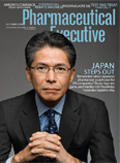Specialty Sales Gets No Resistance
Cubist Pharmaceuticals CEO Michael Bonney has given the company a successful start-and is now predicting the future of drug resistance.
Cubist Pharmaceuticals has been on a tear. Its flagship drug Cubicin, an IV antibiotic to treat complicated bacterial infections, was the most successful antibiotic launch in US history, based on sales—and the drug is only growing stronger. As the rates of the deadly methicillin-resistant staph aureus infection rise, physicians are using the drug even more. Total revenues for the second quarter of 2008 increased 46 percent over the same period in 2007, reaching a total of $101.8 million.

Michael Bonney
The company offers an example of stand-out success in the antibiotic market—which is no small feat, given the changing regulatory standards and concern over the rise of resistance to new therapies. But more broadly, it offers a model for other companies who want to better understand how to launch specialty drugs and maneuver within the US specialty space. (Or in the case of AstraZeneca, which signed the company up to promote its injectable antibiotic Merrem, how to find a new partner.)
Here, CEO Michael Bonney sat down with Pharm Exec to talk about how the company built Cubicin's success through specific targeting of customers and focused messages.
Cubicin has become an example of launch excellence. What did the company do to position the drug for such a strong start?
We were building Cubist from scratch in 2003, and it's often easier to create something new with a blank sheet of paper than it is to change something that's been in existence. Change is hard for large, complex organizations to do well.
There are also few incentives that are as powerful as the fear of failure—and in a small company, you clearly have far less margin for failure. The financial realities of our situation at the time of launch made that an easier orientation to act upon. The balance sheet was in pretty tough shape, and we had to hire 75 sales people to launch this drug—so we had to be successful. It brought out this kind of innate humility and willingness amongst the executives to say, there might be a better way to do this. There was not a view that we knew everything or that we had all the answers. We all have the confidence of past successes to be willing to look at the situation objectively, and to change how we're doing things, if the data suggests that we could be doing it better.
Of course, on top of all that there's a high degree of personal accountability inherent in our executive team. All of the executives here felt and feel as though it was their individual, personal responsibilities to ensure that Cubist was successful. If you can harness that energy, as I think we've done, you can accomplish some extraordinary things.
How did the marketing model for Cubicin evolve?
I don't think you can ever be successful without a good product. Our chief scientific officer at the time anticipated that there would be this explosion in MRSA, so the timing was not accidental.
In terms of marketing, we came at it with knowledge of how the industry works, knowledge of the acute antibiotic marketplace, but with, really, all of our key assumptions on the table and a willingness to question all of those. We built an organization designed for the 21st century, and we built it knowing that we weren't going to predict the future with any high degree of certainty.
We originally positioned Cubicin as the new staph drug, not just the new MRSA drug. But it became apparent within six months or so of launch that where doctors really saw unmet medical need—and where we actually had a lot more credibility—was in methicillin-resistant staph aureus, so that actually was an amendment to the launch platform within the first year of launch.
We also decided to distribute the product differently than most organizations. Instead of stocking wholesalers, we went directly to hospitals. That allowed us to see, in real time, who was buying the drug, which was incredibly important for our sales people. It allowed them to go to the hospitals knowing the successes and challenges of prescribers. We learned how physicians were using the drug quicker than you would typically see in a hospital-based launch.
Given the issue of antibiotic resistance, how do you balance promotion for the drug with the message of responsible use?
I'm actually very proud of the failed Phase III study that occurred in 2002. The data from that study showed that this was not a good drug for pneumonia. We probably spent as much time in the first year of launching this drug making sure physicians understood that [issue] as we did talking about Cubicin for its approved indication for complicated skin infections.
We have a relentless commitment to ensuring that the drug is appropriately used—and we talk a lot about appropriate use starting from the orientation sessions for new employees. We try to stay focused on the question, "What information would you like your physician to have if you developed a serious infection?" And that really guides how we promote the drug. It's not about any kind of slick, Madison Avenue marketing messaging. It's about being true to what the drug can and cannot do.
What's your reaction to the changing standards for antibiotic drug development at FDA?
We can deal with most standards. What we're looking for is clarity. The uncertainty has grown in the past few years about what standards are going to be applied by FDA to register a new antibiotic in certain indications, such as pneumonia. In fact, that uncertainty has had a chilling effect on the amount of money that capital markets or individual companies are willing to invest in new antibiotics. But if they could land on some specific guidance, then we could let our own bright people figure out how we get the data to meet that guidance.
Even draft guidance would help provide some framework. If we start seeing decisions that are consistent with the draft guidance, then it provides the kind of clarity and transparency that I think any company really needs from its governing regulatory body.
Bacteria evolve so quickly. How can drug development keep up?
Our most recent addition to the pipeline is Ecallantide, which is a Phase II compound. We see that cardiothoracic surgery is likely to continue, particularly with the aging population, and that there is an enormous unmet medical need here for clean surgical fields, reduced bleeds, fewer transfusions, as well as better outcomes.
But aside from that, a core part of our business is understanding microbes and how they develop resistance and what the most current thinking is in terms of how to deal with those mechanisms of resistance. Some of our new antibiotics are responsive to early indicators of new trends. There was a new strain of C.difficile identified in Quebec, back about four or five years ago. These new strains produce toxins at 10 to 20 times the volume compared with previous strains, and we anticipate that this will become a big problem. There aren't a lot of treatment options for these patients.
In many academic institutions, we're seeing Klebsiella and Acinetobacters and e-colis that are resistant to all antibiotics today, so we've been hard at work for a couple of years now, trying to identify new molecules that can deal with some of these pan-resistant gram negative infections. It takes a long time to develop a new drug, and by the time this makes it to the market, our expectation is that these pan-resistant gram negatives are going to be a big problem, not unlike MRSA today. They're the next generation of super bugs.
Industry Insider Michael Bonney has served as president and CEO of Cubist Pharmaceuticals since June 2003. Before that, he served as chief operating officer. From 1995 to 2001, he held various positions at Biogen—including vice president of sales and marketing from 1999 to 2001—where he built the commercial infrastructure for the launch of Avonex.
Addressing Disparities in Psoriasis Trials: Takeda's Strategies for Inclusivity in Clinical Research
April 14th 2025LaShell Robinson, Head of Global Feasibility and Trial Equity at Takeda, speaks about the company's strategies to engage patients in underrepresented populations in its phase III psoriasis trials.
Beyond the Prescription: Pharma's Role in Digital Health Conversations
April 1st 2025Join us for an insightful conversation with Jennifer Harakal, Head of Regulatory Affairs at Canopy Life Sciences, as we unpack the evolving intersection of social media and healthcare decisions. Discover how pharmaceutical companies can navigate regulatory challenges while meaningfully engaging with consumers in digital spaces. Jennifer shares expert strategies for responsible marketing, working with influencers, and creating educational content that bridges the gap between patients and healthcare providers. A must-listen for pharma marketers looking to build trust and compliance in today's social media landscape.
Bristol Myers Squibb’s Cobenfy Falls Short in Phase III Trial as Add On Therapy for Schizophrenia
April 23rd 2025In the Phase III ARISE trial, Cobenfy administered as an adjunctive treatment to atypical antipsychotics for patients with inadequately controlled schizophrenia did not achieve statistically significant improvements.
